Life in Nazi Germany: 1933-1939
After the 1933 General Election, Chancellor Adolf Hitler proposed an Enabling Bill that would give him dictatorial powers. Such an act needed three-quarters of the members of the Reichstag to vote in its favour. All the active members of the Communist Party, were in prison, in hiding, or had left the country (an estimated 60,000 people left Germany during the first few weeks after the election). This was also true of most of the leaders of the other left-wing party, Social Democrat Party (SDP). However, Hitler still needed the support of the Catholic Centre Party (BVP) to pass this legislation. Hitler therefore offered the BVP a deal: vote for the bill and the Nazi government would guarantee the rights of the Catholic Church. The BVP agreed and when the vote was taken on 24th March, 1933, only 94 members of the SDP voted against the Enabling Bill. (1)
Soon afterwards the Communist Party and the Social Democrat Party became banned organisations. Party activists still in the country were arrested. A month later Hitler announced that the Catholic Centre Party, the Nationalist Party and all other political parties other than the NSDAP were illegal, and by the end of 1933 over 150,000 political prisoners were in concentration camps. Hitler was aware that people have a great fear of the unknown, and if prisoners were released, they were warned that if they told anyone of their experiences they would be sent back to the camp. (2)
It was not only left-wing politicians and trade union activists who were sent to concentration camps. The Gestapo also began arresting beggars, prostitutes, homosexuals, alcoholics and anyone who was incapable of working. Although some inmates were tortured, the only people killed during this period were prisoners who tried to escape and those classed as "incurably insane". (3)
The Labour Front
Hitler proclaimed May Day, 1933, as a national holiday and arranged to celebrate it as it had never been celebrated before. Trade union leaders were flown to Berlin from all parts of Germany. Joseph Goebbels staged the greatest mass demonstration Germany had ever seen. Hitler told the workers' delegates: "You will see how untrue and unjust is the statement that the revolution is directed against the German workers." Later that day Hitler told a meeting of more than 100,000 workers that "re-establishing social peace in the world of labour" would soon begin. (4)
The next day, Hitler ordered the Sturm Abteilung (SA) to destroy the trade union movement. Their headquarters throughout the country were occupied, union funds confiscated, the unions dissolved and the leaders arrested. Large numbers were sent to concentration camps. Within a few days 169 different trade unions were under Nazi control. (5)
Hitler gave Robert Ley the task of forming the German Labour Front (DAF). Ley, in his first proclamation, stated: "Workers! Your institutions are sacred to us National Socialists. I myself am a poor peasant's son and understand poverty... I know the exploitation of anonymous capitalism. Workers! I swear to you, we will not only keep everything that exists, we will build up the protection and the rights of the workers still further." (6)
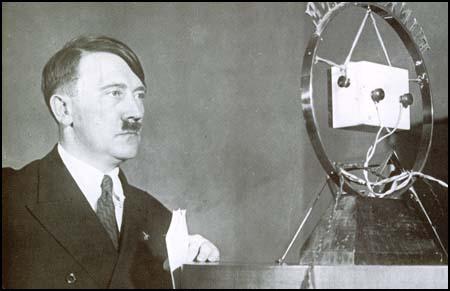
Three weeks later Hitler decreed a law bringing an end to collective bargaining and providing that henceforth "labour trustees", appointed by him, would "regulate labour contracts" and maintain "labour peace". Since the decisions of the trustees were to be legally binding, the law, in effect, outlawed strikes. Ley promised "to restore absolute leadership to the natural leader of a factory - that is, the employer... Only the employer can decide." (7)
The German Labour Front was the only union organization allowed in the Third Reich and had over 20 million members. Ley appointed twelve state officials whose job it was to regulate wages, conditions of work and labour contracts in each of their respective districts, and to maintain peace between workers and employers. (8) The DAF was "rendered totally docile and workers no longer had any voice in management". (9)
The results of the elections to works councils suggest that the Labour Front representatives were not popular with the German workforce. As a result, no further elections were held after 1935. Some workers continued to resist fascism and in some sectors, such as metal and wood workers, railwaymen and seafarers maintained impressive illegal networks. (10)
Education in the Weimar Republic
The social historian, Richard Grunberger, has argued in A Social History of the Third Reich (1971) that when Adolf Hitler came to power in 1933 he inherited a very conservative educational system: "The influence of Germany's educational system on her national fortunes invites comparison with that of the playing-fields of Eton on the Battle of Waterloo. It was in the classrooms that the foundations were laid for Bismarck's victories over Danes, Austrians and French abroad and over German parliamentarians at home." (11)
Hitler held very strong opinions on education. The only teacher he liked at secondary school was Leopold Potsch, his history master. Potsch, like many people living in Upper Austria, was a German Nationalist. Potsch told Hitler and his fellow pupils of the German victories over France in 1870 and 1871 and attacked the Austrians for not becoming involved in these triumphs. Otto von Bismarck, the first chancellor of the German Empire, was one of Hitler's early historical heroes. (12)
Hitler wrote in Mein Kampf (1925): "Dr. Leopold Potsch... used our budding nationalistic fanaticism as a means of educating us, frequently appealing to our sense of national honor. By this alone he was able to discipline us little ruffians more easily than would have been possible by any other means. This teacher made history my favorite subject. And indeed, though he had no such intention, it was then that I became a little revolutionary. For who could have studied German history under such a teacher without becoming an enemy of the state which, through its ruling house, exerted so disastrous an influence on the destinies of the nation? And who could retain his loyalty to a dynasty which in past and present betrayed the needs of the German people again and again for shameless private advantage?" (13)
Changes to the School Curriculum
Hitler immediately made changes to the school curriculum. Education in "racial awareness" began at school and children were constantly reminded of their racial duties to the "national community". Biology, along with political education, became compulsory. Children learnt about "worthy" and "unworthy" races, about breeding and hereditary disease. "They measured their heads with tape measures, checked the colour of their eyes and texture of their hair against charts of Aryan or Nordic types, and constructed their own family trees to establish their biological, not historical, ancestry.... They also expanded on the racial inferiority of the Jews". (14)
As Louis L. Snyder has pointed out: "There were to be two basic educational ideas in his ideal state. First, there must be burnt into the heart and brains of youth the sense of race. Second, German youth must be made ready for war, educated for victory or death. The ultimate purpose of education was to fashion citizens conscious of the glory of country and filled with fanatical devotion to the national cause." (15)
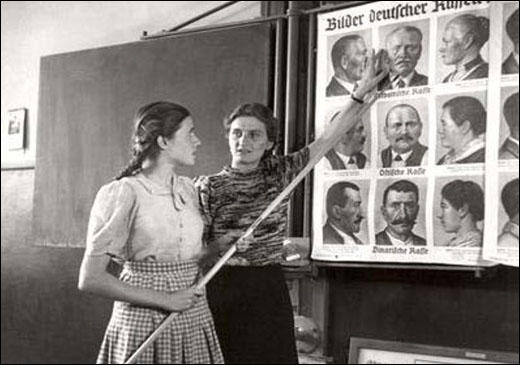
The Minister of the Interior, Wilhelm Frick, claimed that the idea that history teaching should be objective was a fallacy of liberalism. (16) "The purpose of history was to teach people that life was always dominated by struggle, that race and blood were central to everything that happened in the past, present and future, and that leadership determined the fate of peoples. Central themes in the new teaching including courage in battle, sacrifice for a greater cause, boundless admiration for the Leader and hatred of Germany's enemies, the Jews." (17)
Hitler appointed the loyal Bernhard Rust as Minister for Education. Rust lost his job as a schoolteacher in 1930 after being accused of having a sexual relationship with a student. He was not charged with the offence because of his "instability of mind". Rust's task was to change the education system so that resistance to fascist ideas were kept to a minimum. (18)
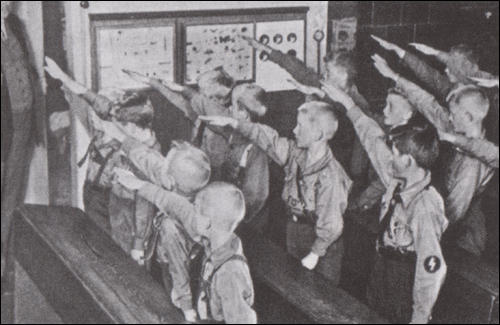
At school the students were taught to worship Adolf Hitler: "As the teacher entered the class, the students would stand and raise their right arms. The teacher would say, For the Führer a triple victory, answered by a chorus of Heil! three times... Every class started with a song. The almighty Führer would be staring at us from his picture on the wall. These uplifting songs were brilliantly written and composed, transporting us into a state of enthusiastic glee." (19)
All school textbooks were withdrawn before new ones were published that reflected the Nazi ideology. Additional teaching materials were issued by Nazi teachers' organizations in different parts of the country. A directive issued in January 1934 made it compulsory for schools to educate their pupils "in the spirit of National Socialism". Children were encouraged to go to school wearing their Hitler Youth and German Girls' League uniforms. School noticeboards were covered in Nazi propaganda posters and teachers often read out articles written by anti-semites such as Julius Streicher. (20)
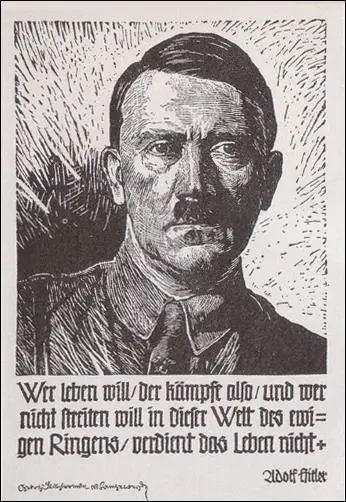
whoever refuses to fight in this world of eternal challenge has no right to live." (c. 1940)
In every schoolbook was an illustration of Hitler with one of his sayings as a frontispiece. Tomi Ungerer claims that his schoolbooks were strewn with pages of sayings from the Führer: "Learn to sacrifice for your fatherland. We shall go onwards. Germany must live. In your race is your strength. You must be true, you must be daring and courageous, and with each other form a great and wonderful comradeship." (21)
Marianne Gärtner went to a private school in Potsdam and noticed a lot of changes after Hitler gained power: "None of my neatly dressed, well-behaved primary-school mates questioned the new books, the new songs, the new syllabus, the new rules or the new standard script, and when - in line with national socialist educational policies - the number of PT periods was increased at the expense of religious instruction or other classes, and competitive field-events added to the curriculum, the less studious and the fast-legged among us were positively delighted." (22)
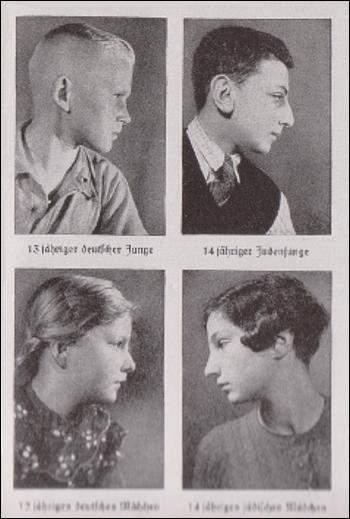
In his autobiography, A Childhood under the Nazis (1998), Tomi Ungerer commented that one of the textbooks that he was forced to use was the anti-Semitic book, The Jewish Question in Education, which contained guidelines for the "identification" of Jews (23). Written by Fritz Fink, with an introduction by Julius Streicher it included passages such as the "Jews have different noses, ears, lips, chins and different faces than Germans" and "they walk differently, have flat feet... their arms are longer and they speak differently." (24)
Some students began to question the way that Jews were portrayed in the classroom. Inge Scholl, later recalled what happened on a trip with the German League of Girls. "We went on trips with our comrades in the Hitler Youth and took long hikes through our new land, the Swabian Jura.... We attended evening gatherings in our various homes, listened to readings, sang, played games, or worked at handcrafts. They told us that we must dedicate our lives to a great cause.... One night, as we lay under the wide starry sky after a long cycling tour, a friend - a fifteen-year-old girl - said quite suddenly and out of the blue, Everything would be fine, but this thing about the Jews is something I just can't swallow. The troop leader assured us that Hitler knew what he was doing and that for the sake of the greater good we would have to accept certain difficult and incomprehensible things. But the girl was not satisfied with this answer. Others took her side, and suddenly the attitudes in our varying home backgrounds were reflected in the conversation. We spent a restless night in that tent, but afterwards we were just too tired, and the next day was inexpressibly splendid and filled with new experiences." (25)
Teachers in Nazi Germany
In 1933 all Jewish teachers were dismissed from German schools and universities. Bernhard Rust explained the reasons for this decision: " As a consequence of the demand thus clearly formulated by the Nuremberg Laws, Jewish teachers and Jewish pupils have had to quit German schools, and schools of their own have been provided by and for them as far as possible. In this way, the natural race instincts of German boys and girls are preserved; and the young people are made aware of their duty to maintain their racial purity and to bequeath it to succeeding generations. " (26)
On her first day at school Elsbeth Emmerich, a Jewish girl, took her teacher flowers. However, her teacher, Frau Borsig, was not impressed: "Frau Borsig... threw the flowers in the bin... One thing she did like to receive from us was Heil Hitler! Every day we had to greet her, and other grown-ups, with the salute. I was used to doing this, but it still embarrassed me. On my way to school one day I went into a busy shop without making the greeting, thinking no one would notice. But a shop assistant pounced on me, saying angrily, Don't you know the German greeting? She made me walk out and come back into the shop again, using the right greeting. I must have blushed to the roots of my long plaited hair as I held my arm out and said, Heil Hitler! in a pretend grown-up voice. Then she started talking loudly to the other customers about children's bad manners nowadays." (27)
Hans Massaquoi was only seven years old when Hitler came to power. His mother was German but his father was African: "In 1933, my first teacher was fired for political reasons. I don't know what her involvements were. Gradually, the old teachers were replaced with younger ones, those with Nazi orientations. Then I began to notice a change in attitude. Teachers would make snide remarks about my race. One teacher would point me out as an example of the non-Aryan race. One time, I must have been ten, a teacher took me aside and said, When we're finished with the Jews, you're next. He still had some inhibitions. He did not make that announcement before the class. It was a private thing. A touch of sadism." (28)
Teachers who did not support the Nazi Party were sacked. One girl who successfully left Nazi Germany when she was sixteen later wrote: "Teachers had to pretend to be Nazis in order to remain in their posts, and most of the men teachers had families which depended on them. If somebody wanted to be promoted he had to show what a fine Nazi he was, whether he really believed what he was saying or not. In the last two years, it was very difficult for me to accept any teaching at all, because I never knew how much the teacher believed in or not." (29)
In 1936 there was a massive drive by Baldur von Schirach to recruit all ten-year-old year olds into the German League of Girls. Posters of fresh-faced, smiling young girls in uniform with swastikas in the background proclaimed "All Ten-Year-Olds To Us" or "All Ten-Year-Olds Belong to Us".
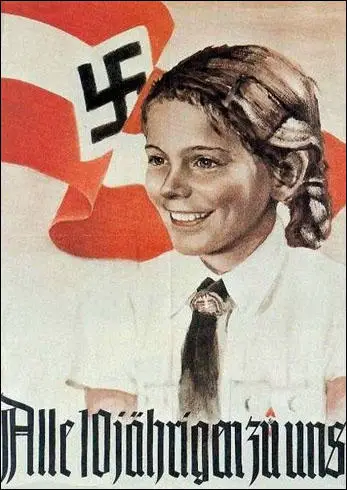
Effie Engel, who went to school in Dresden, pointed out: "The progressive teachers in our school all left and we got a number of new teachers. In my last two years of school, we got some teachers who had already been reprimanded. The fascists allowed them to be reinstated if they thought they were no longer compromised by anything else. But I also knew two teachers who never got a job again in the entire Hitler period.... One of the new teachers was in the SA and came to school in his uniform. I couldn't stand him. In part, we couldn't stand him because he was so loud and crude." (30)
It has been estimated that by 1936 over 32 per cent of teachers were members of the Nazi Party. This was a much higher figure than for other professions. Teachers who were members, wore their uniforms in the classroom. The teacher would enter the classroom and welcome the group with a ‘Hitler salute’, shouting "Heil Hitler!" Students would have to respond in the same manner. It has been claimed that before Adolf Hitler took power a large proportion pf teachers were members of the German Social Democratic Party. One of the jokes that circulated in Germany during this period referred to this fact: "What is the shortest measurable unit of time? The time it takes a grade-school teacher to change his political allegiance." (31)
German Education (May 1933)
By 1938 two-thirds of all elementary school teachers were indoctrinated at special camps in a compulsory one-month training course of lectures. What they learned at camp they were expected to pass on to their students. (32) Headmasters were instructed to dismiss teachers who were not supporters of Hitler. However, some anti-Nazi teachers survived: "I am trying through the teaching of geography to do everything in my power to give the boys knowledge and I hope later on, judgment, so that when, as they grow older, the Nazi fever dies down and it again becomes possible to offer some opposition they may be prepared. There are four or five masters who are non-Nazis left in our school now, and we all work on the same plan. If we leave, Nazis will come in and there will be no honest teaching in the whole school. But if I went to America and left others to do it, would that be honest, or are the only honest people those in prison cells? If only there could be some collective action amongst teachers." (33)
Hitler Youth and Education
By 1938 there were 8,000 full-time leaders of the Hitler Youth. There were also 720,000 part-time leaders, often schoolteachers, who had been trained in National Socialist principles. One teacher, who was hostile to Hitler, wrote to a friend: "In the schools it is not the teacher, but the pupils, who exercise authority. Party functionaries train their children to be spies and agent provocateurs. The youth organizations, particularly the Hitler Youth, have been accorded powers of control which enable every boy and girl to exercise authority backed up by threats. Children have been deliberately taken away from parents who refused to acknowledge their belief in National Socialism. The refusal of parents to 'allow their children to join the youth organization' is regarded as an adequate reason for taking the children away." (34)
Teachers constantly feared the possibility that their Hitler Youth students would inform on them. Herbert Lutz went to a school in Cologne. "My favorite teacher was my math teacher. I remember that one day he asked me a question. I was wearing my uniform, and I stood up, clicked my heels, and he blew up." The teacher shouted: "I don't want you to do this. I want you to act like a human being. I don't want machines. You're not a robot." After the lesson he called Lutz into his office and apologized. Lutz later recalled: "He was probably afraid that I might report him to the Gestapo." (35)
For example, a 38-year-old teacher in Düsseldorf told a joke to her class of twelve-year-olds, that was slightly critical of Adolf Hitler. She immediately realised that she had made a mistake and pleaded with the children not to tell anybody about it. One of the children told his parents and they promptly informed the Gestapo. She immediately lost her job and sent to prison. (36)
Tomi Ungerer claims that his teachers encouraged his students to inform on his parents. "We were promised a reward of money if we denounced our parents or our neighbours - what they said or did... We were told: Even if you denounce your parents, and if you should love them, your real father is the Führer, and being his children you will be the chosen ones, the heroes of the future." (37)
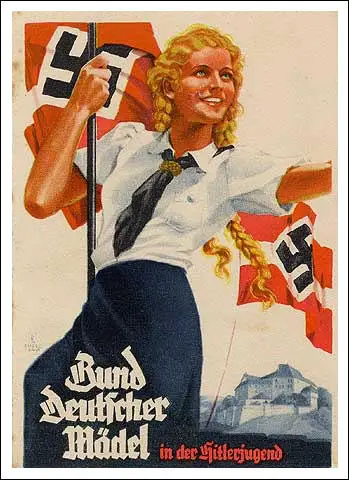
Irmgard Paul went to school in Berchtesgaden. "Fräulein Hoffmann, a slender, short woman of indeterminate age, welcomed me and assigned me a seat. After the first morning I knew that she was not the ogre that Fräulein Stöhr had been but that she too was a Nazi fanatic, more dangerous, it turned out, than Stöhr... Monday mornings each pupil had to weigh in with at least two pounds of used paper and a ball of smoothed-out silver aluminum foil to help with the war effort."
One day Irmgard asked her grandfather asked if she could take some of his old journals to school to help Germany win the war. "He looked at me as if he had not quite understood my question and then said in a calm, icy tone that not a sliver of any of his magazines would go to support the war of that scoundrel Hitler... How dare he not support the war that we were told every day was a life-and-death struggle for the German people? I left the workshop without the journals but what I felt would be a permanent resentment against my grandfather."
Soon afterwards Fräulein Hoffmann invited Irmgard Paul to her home "to have a special treat of hot chocolate and cookies at her house". It was not long before Irmgard discovered why she had been asked to visit her teacher: "After a few polite words she asked point-blank what my grandfather thought about Adolf Hitler and what he said about the war. I was still angry with my grandfather but stalled, sitting uncomfortably on the moss green, upholstered chair in Fräulein Hoffmann's living room, weighing my feelings against my answer. On the one hand, grandfather was withholding paper for the war effort... On the other hand, he was my grandfather. I knew the twinkle in his eyes when he was amused and had seen tears running down his face when one after another the messages arrived that both his apprentices had been killed on the eastern front... After much too long a pause I came to the decision that I liked this nosy teacher less than my grandfather."
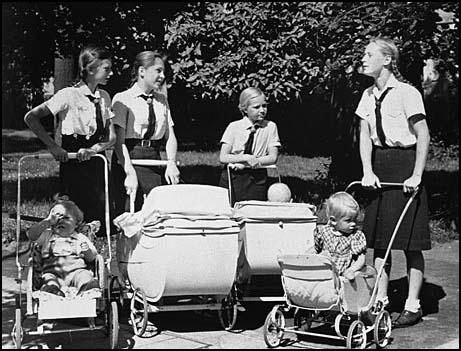
large families to visit the park while the mothers of the infants were at work.
Irmgard Paul commented in her autobiography, On Hitler's Mountain: My Nazi Childhood (2005): "Although I did not know it that day, Fräulein Hoffmann was a Nazi informer, and my telling the truth would have sent grandfather to a concentration camp. Something had made me protect my grandfather, but it took a long time before I realized how lucky I (and he) had been in making that decision. On that particular day, though, I felt thoroughly sick of these conflicts forced on me by adults." (38)
Hildegard Koch was a member of the League of German Girls (BDM), the female branch of the Hitler Youth movement. She later recalled how the students controlled the curriculum: "As time went on more and more girls joined the BDM, which gave us a great advantage at school. The mistresses were mostly pretty old and stuffy. They wanted us to do scripture and, of course, we refused. Our leaders had told us that no one could be forced to listen to a lot of immoral stories about Jews, and so we made a row and behaved so badly during scripture classes that the teacher was glad in the end to let us out." (39)
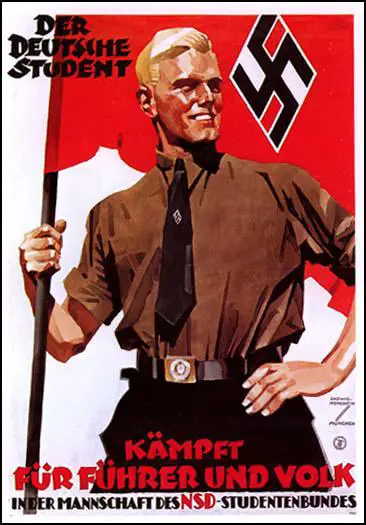
Erich Dressler played an active role in getting rid of teachers he considered not to be supporters of the Nazi Party: "In 1934, when I had reached the age of ten, I was sent to the Paulsen Realgymnasium. This was still a regular old-fashioned place with masters in long beards who were completely out of sympathy with the new era. Again and again we noticed that they had little understanding for the Führer's maxim - the training of character comes before the training of intellect.They still expected us to know as much as the pupils used to under the Jewish Weimar Republic, and they pestered us with all sorts of Latin and Greek nonsense instead of teaching us things that might be useful later on. This brought about an absurd state of affairs in which we, the boys, had to instruct our masters. Already we were set aflame by the idea of the New Germany, and were resolved not to be influenced by their outdated ideas and theories, and flatly told our masters so. Of course they said nothing, because I think they were a bit afraid of us, but they didn't do anything about changing their methods of teaching."
It was decided to get rid of the Latin teacher. "Our Latin master set us an interminable extract from Caesar for translation. We just did not do it, and excused ourselves by saying that we had been on duty for the Hitler Youth during the afternoon. Once one of the old birds got up courage to say something in protest. This was immediately reported to our Group Leader who went off to see the headmaster and got the master dismissed. He was only sixteen, but as a leader in the Hider Youth he could not allow such obstructionism to hinder us in the performance of duties which were much more important than our school work.... Gradually the new ideas permeated the whole of our school. A few young masters arrived who understood us and who themselves were ardent national socialists. And they taught us subjects into which the national revolution had infused a new spirit. One of them took us for history; another for racial theory and sport. Previously we had been pestered with the old Romans and such like; but now we learned to see things with different eyes. I had never thought much about being well educated; but a German man must know something about the history of his own people so as to avoid repeating the mistakes made by former generations." (40)
Teachers encouraged members of the Hitler Youth to inform on their parents. For example, they set essays entitled "What does your family talk about at home?" According to one source: "Parents... were alarmed by the gradual brutalisation of manners, impoverishment of vocabulary and rejection of traditional values... Their children became strangers, contemptuous of monarchy or religion, and perpetually barking and shouting like pint-sized Prussian sergeant-majors." (41)
Ilse Koehn started high school in 1939. She found that the young teachers were strong supporters of Adolf Hitler. "Dr. Lauenstein was the only male teacher. Young and tall, handsome too, he was quite a contrast to the ladies, who were all in their fifties. He alone wore the Nazi Party button, shouted Heil Hitler when he entered the classroom and spent the next fifteen minutes expounding on the Führer's Blood and Soil philosophy. Old German soil soaked with German blood, as he put it. He was unbearably bombastic when he talked about the superior Aryan race. When he finally turned to Goethe, there was always a sigh of relief. No one, certainly not I, had any idea what he had been talking about." (42)
Irmgard Paul first went to her Berchtesgaden school in April 1940. "From the day mother delivered me into Fräulein Stöhr's clutches it was obvious that this woman was a fanatical Nazi. A true believer. Surely she had become a teacher not because she had an affinity for children but because she wanted to tyrannize them. The Nazi doctrines designed to raise citizens wholly obedient to the Führer's bidding captivated and excited her... The war had already eaten into resources and materials, as well as the supply of male teachers, most of whom were drafted. As a result, Fräulein Stöhr got to sink her fangs into one hundred children belonging to three different grades. We were huddled together in her stark, whitewashed classroom learning the basics by rote plus a bit of local history, needlework for the girls, and geography."
Irmgard's father was killed in France on 5th July, 1941. "People in Berchtesgaden reacted in two different ways to his death - our friends, relatives, and neighbours, with sadness and compassion; the Nazi officials in our lives with pompous, irrelevant condolences. My father's boss, Herr Adler, who for unknown reasons was not drafted, came by - in his S.A. uniform, no less - a few days after the news arrived and said in an oily voice to my stricken mother, Chin up, Frau Paul, chin up. He died for the Führer."
"The morning after we got the death notice, my teacher, Fräulein Stöhr, a fanatical Nazi, ordered me to stand up in front of the class and tell everyone how proud I was that my father had given his life for the Führer. I stood before those hundred children, my face burning, my hurt heart thumping. I clenched my fists and swallowed hard, determined not to cry or otherwise show anyone how I felt. I forced myself to drain all emotion from my voice, even forcing my mouth into a grin, and said, Yes, we heard yesterday that my father died in France for the Führer. Heil Hitler. My face was flushed, but I made sure to walk calmly back to my seat." (43)
According to one report the activities of the Hitler Youth and the Nazi government was slowly destroying the education system in Germany. "Everything that has been built up over a century of work by the teaching profession is no longer there in essence... They have been wilfully destroyed from above. No thought any more of proper working methods in school, or of the freedom of teaching. In their place we have cramming and beating schools, prescribed methods of learning and... learning materials. Instead of freedom of learning, we have the most narrow-minded school supervision and spying on teachers and pupils. No free speech is permitted for teachers and pupils, no inner, personal empathy. The whole thing has been taken over by the military spirit." (44)
School Textbooks
New mathematic textbooks were introduced and included "social arithmetic", which "involved calculations designed to achieve a subliminal indoctrination in key areas - for example, sums requiring the children to calculate how much it would cost the state to keep a mentally ill person alive in an asylum." (45) Other questions used in mathematics revolved around artillery trajectories and fighter-to-bomber ratios. This was a typical question from a mathematics text: "An airplane flies at the rate of 240 kilometers per hour to a place at a distance of 210 kilometers in order to drop bombs. When may it be expected to return if the dropping of bombs takes 7.5 minutes?" (46)
Geography textbooks were produced that "propagated concepts such as living-space and blood and soil, and purveyed the myth of Germanic racial superiority". (47) Biology textbooks emphasized Hitler's views on race and heredity. One popular textbook used had been written by Hermann Gauch: "The animal world can be classified into Nordic men and lower animals. We are thus able to establish the following principle: there exist no physical or psychological characteristics which would justify a differentiation of mankind from the animal world. The only differences that exist are those between Nordic men, on the one hand, and animals... including non-Nordic men." (48)
Art was Tomi Ungerer favourite subject. His teacher praised him for his work and he was told: "The Führer needs artists - he himself is one." The government had taken complete control of the art world. "Under the Nazis, painters and sculptors were paid a monthly salary from the state." Textbooks used in the classroom were very hostile to modern art, something that was considered to be degenerate. Below is a school textbook that provides a comparative study between modern paintings and deformed humans. For example, the Amedeo Modigliani (plate 126 person) is compared to a person with Down's Syndrome. (49)
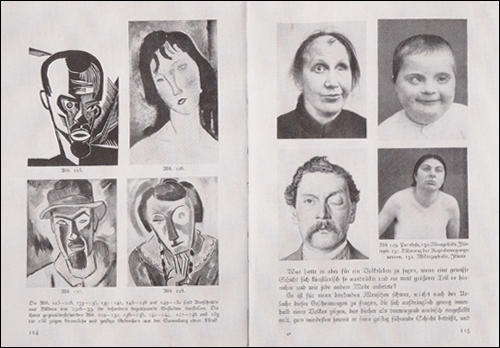
At school Irmgard Paul was brainwashed into accepting Nazi views on the Jewish race. "We used a book with page after page showing the physical differences between Jews and Germans in grotesque drawings of Jewish noses, lips, and eyes. The book encouraged every child to note these differences and to bring anyone who bore Jewish features on the attention of our parents or teachers. I was horrified by the crimes Jewish people were being accused of - killing babies, loan-sharking, basic dishonesty, and conspiring to destroy Germany and rule the world. The description of the Jewish people would convince any child that these were monsters, not people with sorrows and joys like ours." (50)
Nazi Elite Schools
Bernhard Rust introduced a Nazi National Curriculum. Considerable emphasis was placed on physical training. Boxing was made compulsory in upper schools and PT became an examination subject for grammar-school entry as well as for the school-leaving certificate. Persistently unsatisfactory performance at PT constituted grounds for expulsion from school and for debarment from further studies. In 1936 timetable allocation of PT periods was increased from two to three. Two years later it was increased to five periods. All teachers below the age of fifty were pressed into compulsory PT courses. (51)
Rust also establishment of élite schools called Nationalpolitische Erziehungsanstalten (Napolas). Selection for entry included racial origins, physical fitness and membership of the Hitler Youth. These schools, run by the Schutzstaffel (SS), had the task of training the next generation of high-ranking people in the Nazi Party and the German Army. (52) The syllabus was that of ordinary grammar schools with political inculcation in place of religious instruction and a tremendous emphasis on such sports as boxing, war games, rowing, sailing, gliding, shooting and riding motor-cycles. Only two out of the thirty-nine Napolas constructed over the next few years catered for girls. (53)
After leaving school at the age of eighteen students joined the German Labour Service where they worked for the government for six months. (54) Some young people then went on to university. Bernhard Rust claimed that the new education system would benefit the children of the working-class that made up 45 per cent of Germany's population. This promise was never fulfilled and after six years in office, only 3 per cent of university students came from working-class backgrounds. This was the same percentage as it was before Adolf Hitler came to power. (55)
Women's Education
One of the objectives of the Nazi government was to reduce the number of women in higher education. On 12th January 1934, Wilhelm Frick ordered that the proportion of female grammar school graduates allowed to proceed to university should be no more than 10 per cent of that of the male graduates. (56) That year, out of 10,000 girls who passed the Abitur entry examinations, only 1,500 were granted university admission. In the year before the Nazis came to power there were 18,315 women students in Germany's universities. Six years later this number had fallen to 5,447. The government also ordered a reduction in women teachers. By 1935 the number of women teachers at girls' secondary schools had decreased by 15 per cent. (57)
Gertrud Scholtz-Klink was placed in charge of the Nazi Mother Service. The organization issued a statement explaining its role in Nazi Germany: "The purpose of the National Mother Service is political schooling. Political schooling for the woman is not a transmission of political knowledge, nor the learning of Party programs. Rather, political schooling is shaping to a certain attitude, an attitude that out of inner necessity affirms the measures of the State, takes them into women's life, carries them out and causes them to grow and be further transmitted."
Joseph Goebbels pointed out in a speech in 1934: "Women has the task of being beautiful and bringing children into the world, and this is by no means as coarse and old-fashioned as one might think. The female bird preens herself for her mate and hatches her eggs for him. In exchange, the mate takes care of gathering the food and stands guard and wards off the enemy. Hope for as many children as possible! Your duty is to produce at least four offspring in order to ensure the future of the national stock." (58)
As Richard Evans, the author of The Third Reich in Power (2005) has pointed out: "The reorganization of German secondary schools ordered in 1937 abolished grammar-school education for girls altogether. Girls were banned from learning Latin, a requirement for university entrance, and the Education Ministry did its best instead to steer them into domestic education, for which a whole type of girls school existed... The number of female students in higher education fell from just over 17,000 in 1932-33 to well under 6,000 in 1939." (59)
Problems in Education
One of the major problems for schools in Nazi Germany was attendance. School authorities were instructed to grant pupils leave of absence to enable them to attend Hitler Youth courses. In one study of a school in Westphalia with 870 pupils showed that 23,000 school days were lost because of extra-mural activities during one academic year. This eventually had an impact on educational achievement. On 16th January, 1937, Colonel Hilpert of the German Army complained in Frankfurter Zeitung, that: "Our youth starts off with perfectly correct principles in the physical sphere of education, but frequently refuses to extend this to the mental sphere... Many of the candidates applying for commissions display a simply inconceivable lack of elementary knowledge." (60)
By 1938 it was reported that there was a problem recruiting teachers. It was claimed that one teaching post in twelve was unfilled and Germany had 17,000 less teachers than it had before Adolf Hitler came to power. The main reason for this was the fall in teacher's pay. Entrants to the profession were offered a starting salary of 2,000 marks per annum. After deductions, this worked out at approximately 140 marks per month, or twenty marks more than was earned by the average lower-paid worker. The government tried to overcome this problem by introducing low-paid unqualified auxiliaries into schools. (61)
Women in the Weimar Republic
After the First World War women in Germany were given the vote and a feminist elite, led by Rosa Luxemburg and Clara Zetkin, helped to shape the political post-war scene. Luxemburg, the leader of the Spartacus League, was murdered by the Freikorps in January, 1919, but other women replaced her at the forefront of politics and by 1932 they had 36 members of the Reichstag. Germany also had 100,000 women teachers, 13,000 women musicians and 3,000 women doctors. (62)
The Wall Street Crash caused serious problems for the German economy. The collapse in share prices meant an urgent need to repatriate American capital invested abroad. The number of registered unemployed in Germany rose from 1.6 million in October 1929 to 6.12 million in February 1932. Since these figures did not include the "invisible" unregistered unemployed, it has been estimated that the true figure was 7.6 million. "Thirty-three per cent of the workforce were without jobs. Taking into account dependants, perhaps twenty-three million people were affected by unemployment." (63)
During the early 1930s women often found it easier to find jobs than men. The main reason was that female labour was cheaper. As Richard Grunberger has pointed out: "Skilled women earned 66 per cent of men's wages, unskilled ones 70 per cent, which explains why during the Depression nearly one man in three (29 per cent) was dismissed but only one woman in every ten (11 per cent)... In 1933 women formed 37 per cent of the total employed labour force in Germany." (64)
During the election campaign in 1932, Adolf Hitler promised that if he gained power he would take 800,000 women out of employment within four years. Hitler told a delegation who had come to discuss women's rights with him he told them the solution was for every woman to have a husband. The American journalist, William L. Shirer, who was working in Germany at the time, has argued that politicians such as Hitler "thrive only... when the masses were unemployed, hungry and desperate". (65)
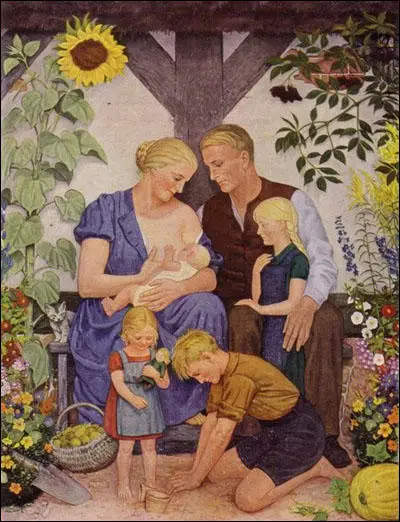
Cate Haste, the author of Nazi Women (2001) has suggested that Hitler was popular with German women. "When Hitler came to power, almost half of those voting for him were women. His promise to restore order and end unemployment held strong appeal. German women had experienced the anarchy of street fighting between rival political gangs on their doorsteps. Unemployment bred uncertainty and discord at the heart of their family lives. Women who worked to keep their families as their husbands lost their jobs, or who saw their standard of life deteriorate, longed for stability and certainty - feelings successfully tapped by Hitler." (66)
Melita Maschmann was a young German woman who supported Hitler because she believed he would bring an end to unemployment: "Part of the misery about which the adults complained daily was unemployment. One could have no conception of what it mean for four, five or even six million people to have no work. Berlin had four million inhabitants…Imagine all the families living in Berlin having scarcely enough dry bread to satisfy their hunger... I believed the National Socialists when they promised to do away with unemployment… I believed them when they said they would reunite the German nation, which had split into more than forty political parties, and overcome the consequences of the dictated peace of Versailles." (67)
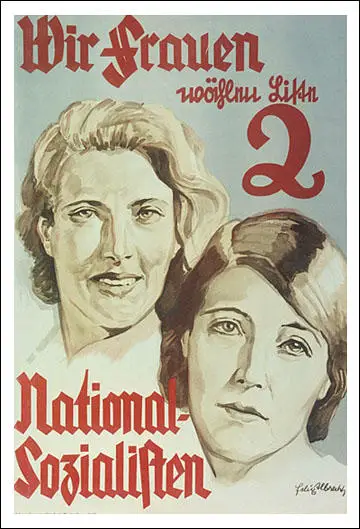
After taking power Hitler's main idea of reducing unemployment amongst men was by taking women out of the labour market. Ministers in the Nazi government made speech after speech encouraging women to allow men to take their jobs. Joseph Goebbels made a very important speech on the subject in March 1933. He pointed out that the Nazi Party had been criticized for keeping "women out of daily politics" in Germany. "We do not see the woman as inferior, but as having a different mission, a different value, than that of the man. Therefore we believed the German woman, who more than any other in the world is a woman in the best sense of the word, should use her strength and abilities in other areas than the man."
Goebbels condemned the idea that women had as much right as men to work. "Looking back over the past years of Germany’s decline, we come to the frightening, nearly terrifying, conclusion that the less German men were willing to act as men in public life, the more women succumbed to the temptation to fill the role of the man. The feminization of men always leads to the masculinisation of women. An age in which all great idea of virtue, of steadfastness, of hardness, and determination have been forgotten should not be surprised that the man gradually loses his leading role in life and politics and government to the woman."
Goebbels then went on to argue that in recent years: "Some good, noble, and commendable things have happened. But also things that are contemptible and humiliating. These revolutionary transformations have largely taken from women their proper tasks. Their eyes were set in directions that were not appropriate for them. The result was a distorted public view of German womanhood that had nothing to do with former ideals. A fundamental change is necessary. At the risk of sounding reactionary and outdated, let me say this clearly: The first, best, and most suitable place for the women is in the family, and her most glorious duty is to give children to her people and nation, children who can continue the line of generations and who guarantee the immortality of the nation. The woman is the teacher of the youth, and therefore the builder of the foundation of the future. If the family is the nation’s source of strength, the woman is its core and centre. The best place for the woman to serve her people is in her marriage, in the family, in motherhood." (68)
Women as Mothers
Adolf Hitler also reinforced this idea. In a speech he made in September 1934, he suggested that the slogan "emancipation of women" was invented by Jewish intellectuals and was clearly associated with Marxism. Women needed to leave the workplace and return to the home. " For her world is her husband, her family, her children, and her home. But what would become of the greater world if there were no one to tend and care for the smaller one? The great world cannot survive if the smaller world is not stable. We do not consider it correct for the women to interfere in the world of the man. We consider it natural if these two worlds remain distinct." (69)
Nazi propaganda was carefully designed to elevate women's role. Motherhood was glorified in posters, paintings and sculptures. "The breastfeeding mother appeared on sometimes graphically deplorable posters and was sculptured for placing in public spaces. Painters depicted mothers surrounded by their families in warm, soft-toned agricultural settings, intended to invoke the peasant rural idyll within which the Nazi fantasy of ideal family life was framed." (70)
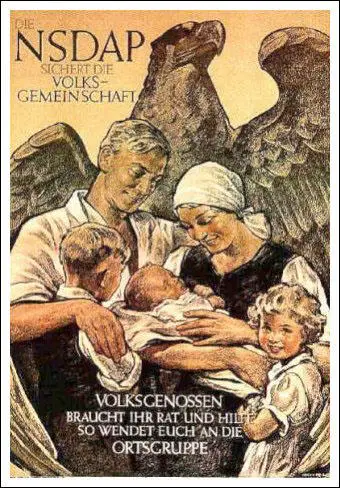
Adolf Hitler returned to the subject a few months later. He argued that the Nazi government was protecting the best interests of women by encouraging them to get married: "The so-called granting of equal rights to women, which Marxism demands, in reality does not grant equal rights but constitutes a deprivation of rights, since it draws the woman into an area in which she will necessarily be inferior. The woman has her own battlefield. With every child that she brings into the world, she fights her battle for the nation." (71)
Marianne Gärtner attended a meeting of the German Girls' League in Potsdam where she was told about the desirability of large, healthy families, the team leader raised her voice: "There is no greater honour for a German woman than to bear children for the Führer and for the Fatherland! The Führer has ruled that no family will be complete without at least four children, and that every year, on his mother's birthday, all mothers with more than four children will be awarded the Mutterkreuz." (Decoration similar in design to the Iron Cross (came in bronze, silver or gold, depending on number of children).
The team leader then asked for questions: "Why isn't the Führer married and a father himself?" Gärtner explained in her autobiography, The Naked Years: Growing up in Nazi Germany (1987): "The question was out before I had time to check myself. It was an innocent question, devoid of any pert insinuation that the Führer ought to practise what he preached. Silence filled the whitewashed room, but the team leader offered neither answer nor reproved the question. She strafed me with a murderous look, then called for attention." The question was never answered. (72)
Reduction of Unemployment
Soon after Hitler gained power he ordered the Reichstag to pass legislation that would reduce male unemployment. Young couples intending to get married could apply in advance for the interest-free loan of up to 1,000 Reichsmarks provided that the prospective wife had been in employment for at least six months in the two years up to the passing of the law. Importantly, she had to give up her job by the time of the wedding and undertake not to enter the labour market again until the loan was paid off, unless her husband lost his job in the meantime. To stimulate production the loans were issued not in cash but in the form of vouchers for furniture and household equipment. (73)
As Richard Evans, the author of The Third Reich in Power (2005), has pointed out: "That this was not a short-term measure was indicated the terms of repayment, which amounted to 1 per cent of the capital per month, so that the maximum period of the loan could be as much as eight and a half years... However, the loans were made more attractive, and given an additional slant, by a supplementary decree issued on 20 June 1933 reducing the amount to be repaid by a quarter for each child born to the couple in question. With four children, therefore, couples would not have to repay anything." (74)
To pay for these loans single men and childless couples were taxed more heavily. The German government also made changes to the law to make marriage an instrument of racial policy. In 1934 the Nazi Racial Policy Bureau introduced ten rules to be observed when considering a marriage partner. This included "Remember you are a German.... Being a German, only choose a spouse or similar or related blood! When choosing your spouse, inquire into his or her forebears... Hope for as many children as possible! Your duty is to produce at least four offspring in order to ensure the future of the national stock." (75)
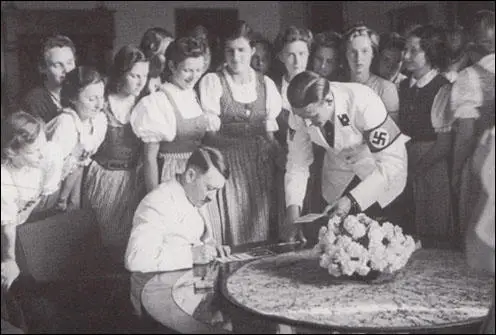
The German government also introduced measures to prevent these loans being obtained by people they did not believe deserved them. All applicants had to undergo a medical examination to see that they were really Aryans. If they had any hereditary diseases or were associated with oppositional movements like the German Communist Party and Social Democrat Party they were turned down for loans. By the end of 1934, around 360,000 women had given up work. (76)
Gertrud Scholtz-Klink
Adolf Hitler appointed Gertrud Scholtz-Klink as Reich Women's Leader and head of the German Girls' League. A good orator, Scholtz-Klink's main task was to promote male superiority and the importance of child-bearing. In one speech she pointed out that: "Woman is entrusted in the life of the nation with a great task, the care of man, soul, body, and mind. It is the mission of woman to minister in the home and in her profession to the needs of life from the first to last moment of man's existence. Her mission in marriage is... comrade, helper and womanly complement of man - this is the right of woman in the New Germany." (77)
In July 1934 Scholtz-Klink was appointed as head of the Women's Bureau in the German Labour Front. She now had responsibility for persuading women to work for the good of the Nazi government. The decline in unemployment after the Nazis gained power meant that it was not necessary to force women out of manual work. However, action was taken to reduce the number of women working in the professions. Married women doctors and civil servants were dismissed in 1934 and from June 1936 women could no longer act as judges or public prosecutors. Hitler's hostility to women was shown by his decision to make them ineligible to jury service because he believed them to be unable to "think logically or reason objectively, since they are ruled only by emotion." (78)
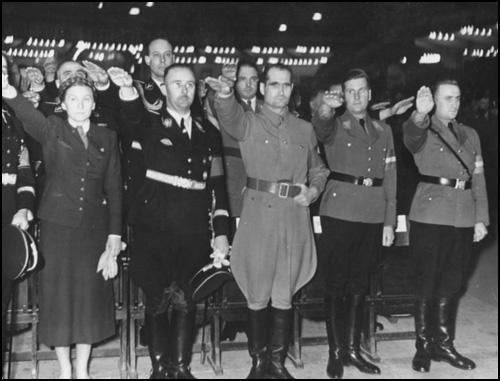
In 1936 Scholtz-Klink published To Be German Is to Be Strong where she argued that it was the role of women to be mothers in Nazi Germany. "Many women were superficially mothers (in the past), but they had forgotten to subordinate themselves to the law of life, which sees the affirmation of a child as the answer of the woman to her people, and also her contribution to the right of her people to survive. Transforming the calling of motherhood to the job of motherhood left children joyless, unhappy, without strength or soul. Devilish forces under the leadership of Marxism attempted to lead German women along this path. It is therefore our task to awaken once again the sense of the divine, to make the calling to motherhood the way through which the German woman will see her calling to be mother of the nation. She will then not live her life selfishly, but rather in service to her people." (79)
Traudl Junge argued that many young women were turned off Nazism by the image projected by Scholtz-Klink. "The Führerin Gertrud Scholtz-Klink was the type we did not like at all. She was just bourgeois and she was so ugly and wasn't fashionable at all. So that was why we didn't bother about joining her organization... It didn't touch me or my friends very much... We were interested in dancing and ballet, and I didn't care much for politics." Junge did not like the message that young women should not wear make-up and had to be "naturally beautiful, sporty and healthy, and giving her leader (Hitler) a lot of children." (80)
Women and Higher Education
One of the objectives of the Nazi government was to reduce the number of women in higher education. On 12th January 1934, Wilhelm Frick ordered that the proportion of female grammar school graduates allowed to proceed to university should be no more than 10 per cent of that of the male graduates. (81) That year, out of 10,000 girls who passed the Abitur entry examinations, only 1,500 were granted university admission. In the year before the Nazis came to power there were 18,315 women students in Germany's universities. Six years later this number had fallen to 5,447. The government also ordered a reduction in women teachers. By 1935 the number of women teachers at girls' secondary schools had decreased by 15 per cent. (82)
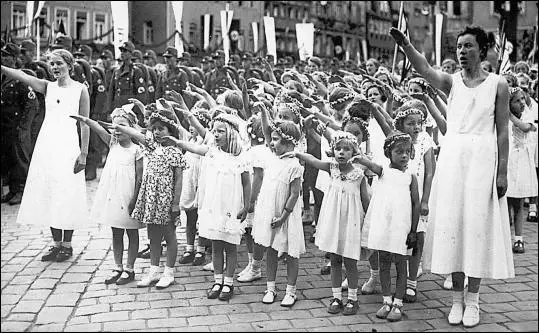
salute and singing the Horst-Wessel, the unofficial anthem of the Nazi Party.
Gertrud Scholtz-Klink was placed in charge of the Nazi Mother Service. The organization issued a statement explaining its role in Nazi Germany: "The purpose of the National Mother Service is political schooling. Political schooling for the woman is not a transmission of political knowledge, nor the learning of Party programs. Rather, political schooling is shaping to a certain attitude, an attitude that out of inner necessity affirms the measures of the State, takes them into women's life, carries them out and causes them to grow and be further transmitted."
Joseph Goebbels pointed out in a speech in 1934: "Women has the task of being beautiful and bringing children into the world, and this is by no means as coarse and old-fashioned as one might think. The female bird preens herself for her mate and hatches her eggs for him. In exchange, the mate takes care of gathering the food and stands guard and wards off the enemy. Hope for as many children as possible! Your duty is to produce at least four offspring in order to ensure the future of the national stock." (83)
As Richard Evans, the author of The Third Reich in Power (2005) has pointed out: "The reorganization of German secondary schools ordered in 1937 abolished grammar-school education for girls altogether. Girls were banned from learning Latin, a requirement for university entrance, and the Education Ministry did its best instead to steer them into domestic education, for which a whole type of girls school existed... The number of female students in higher education fell from just over 17,000 in 1932-33 to well under 6,000 in 1939." (84)
The Schutzstaffel (SS) also established bridal schools. Gertrud Draber later recalled: "I wanted to be a perfect housewife. And I wanted to do something different with my life, not just be a working girl in an office... None of us had a clue about running a household. So we were taught everything that was necessary to be a woman; house-keeping, being a mother, and being a good wife... My main aim as a woman was above all, and as soon as possible... to become a mother. That was my main ambition." (85)
Efforts to "propagate the master race" ended in failure. SS members managed by 1939 to produce on average only 1.1 children and the SS leaders a mere 1.4 children. This was far short of the four required by the State. Despite constant pressure, 43 per cent of SS members remained unmarried. (86)
Lebensborn
Heinrich Himmler urged members of the Schutzstaffel (SS) to get married and introduced a system where the more children they had, the less money they paid in tax. For example, "the deduction for a thirty-four-year-old married captain with no children was 3 per cent, with one child 2 per cent, two children 1.25 per cent and three children 0.4 per cent." (87)
Himmler also introduced regulations about the type of women SS members were allowed to marry. As one woman pointed out what happened when Ernst Trutz, an SS officer, proposed marriage: "He said I was a model of purebred Nordic Germanic woman.... and it was a sacred duty to give the Führer as many fine children as possible.... As the children of the SS men were going to be the new ruling class of Germany they had to be very careful that the women were not racially objectionable and had the right sort of physique to produce plenty of children. The marriage permit was only granted after an investigation by the Reich Ancestry Office and a medical examination by SS doctors." (88)
It became clear that even with these reforms not enough to encourage SS officers to have large families. The SS couple were expected to produce at least four children, but in fact the SS birthrate remained average for the country as a whole. (89) In December 1935 Himmler founded Lebensborn to care for unmarried mothers of "good blood" made pregnant by SS men. It was an attempt to stop these men arranging abortions and the consequent loss to the nation of "valuable" racial stock. These babies were then placed with SS families who wanted to adopt children. (90)
The first Lebensborn home was opened in 1936 in Steinhöring. Later that year Heinrich Himmler informed SS officers that the purpose of the programme was to: "(i) Support racially, biologically and hereditarily valuable families with many children. (ii) Place and care for racially, biologically and hereditarily valuable pregnant women, who, after thorough examination of their and the progenitor's families by the Race and Settlement Central Bureau of the SS, can be expected to produce equally valuable children." (91) Himmler used these maternity homes to promote the virtues of porridge and wholemeal bread. (92)
During this period an attempt was made to change views on illegitimate children. Adolf Hitler was quoted as saying that as long as there was an imbalance in the population of childbearing age, people "shall be forbidden to despise the child born out of wedlock". (93) According to Lisa Pine, the author of Nazi Family Policy (1997), the Nazi state no longer saw the single mother as "degenerate" and placed the single mother who had given a child life, higher than the woman who had "avoided having children in her marriage on egotistical grounds". (94)
It has been argued by the historian, Cate Haste, that in the 1930s "most European countries stigmatized unmarried mothers as a threat to the institution of marriage". In Nazi Germany, however, motherhood and procreation by women of "good blood" were so highly valued that steps were taken to "re-cast the image of the unmarried mother and illegitimate child". It was claimed the "bourgeois concept of marriage and morality was outmoded as far as Nazi population policy was concerned. (95) The Nazi campaign was "designed to confer parity of status as well as of public esteem on unmarried mothers and their offspring". (96)
Heinrich Himmler explained to his masseur, Felix Kersten: "Only a few years ago illegitimate children were considered a shameful matter. In defiance of the existing laws I have systematically influenced the SS to consider children, irrespective of illegality or otherwise, the most beautiful, and best thing there is. The results - today my men tell me with shining eyes that an illegitimate son has been born to them. Their girls consider it an honour, not a source of shame, in spite of existing legal circumstances." (97)
Leaders of the German Girls' League (BDM) were instructed to recruit young women with the potential to become good breeding partners for SS officers. Hildegard Koch was an 18 year-old member of the BDM in Berlin. She later recalled that she always appeared in the front line during BDM parades. "The Gau Leader herself had picked me from amongst hundreds of girls. I was half a head taller than the tallest of them and had wonderful long blonde hair and bright blue eyes.... Once I was photographed and my picture appeared on the tide page of the BDM journal Das deutsche Mädel." (98)
Hildegard was told by her BDM leader: "What Germany needs more than anything is racially valuable stock". She said that "Heinrich Himmler had been charged by the Führer with the task of coupling a small elite of German women (who had to be purely Nordic and over five foot tall) with SS men of equally good racial stock in order to lay the foundation of a pure racial breed.... We had to sign an undertaking renouncing all claims to the the children we would have there, as they would be needed by the State and would be taken to special houses and settlements for inter-marriage."
Hilegard was sent to an old castle near Tegernsee. "There were about 40 girls all about my own age. No one knew anyone else's name, no one knew where we came from. All you needed to be accepted there was a certificate of Aryan ancestry as far back at least as your great grandparents. This was not difficult for me. I had one that went back to the sixteenth century, nor had there ever been a smell of a Jew in our family." (99)
Jean Schlösser, a young woman from Cologne, was also sent to Tegernsee: "At the Tegernsee hostel, I waited until the tenth day after the beginning of my period and was medically examined; then I slept with an SS man who had also to perform his duty with another girl. When pregnancy was diagnosed, I had the choice of returning home or going straight into a maternity home... The birth was not easy, but no good German woman would think of having artificial injections to deaded the pain." (100)
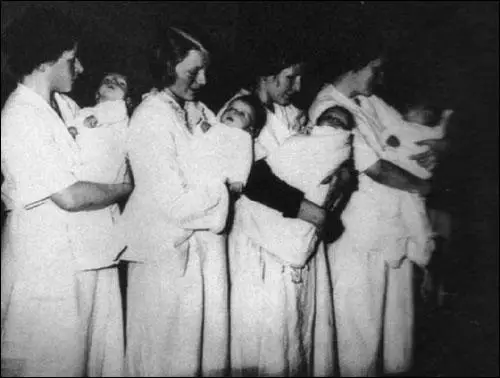
Hildegard Koch was introduced to several SS men at the Lebensborn maternity home. "They were all very tall and strong with blue eyes and blond hair... We were given about a week to pick the man we liked and we were told to see to it that his hair and eyes corresponded exactly to ours. We were not told the names of any of the men. When we had made our choice we had to wait till the tenth day after the beginning of the last period, when we were again medically examined and given permission to receive the SS men in our rooms at night... He was a sweet boy, although he hurt me a little, and I think he was actually a little stupid, but he had smashing looks. He slept with me for three evenings in one week. The other nights he had to do his duty with another girl. I stayed in the house until I was pregnant, which didn't take long." A boy was born but she was only able to stay with him for two weeks before handing him over to the SS. Hildegard agreed to come back in a year's time in order to provide another child for the regime. (101)
There were 14 Lebensborn clinics established in Germany and Austria. (102) Attempts were made to keep details of the SS breeding programme secret. Doctors swore an SS oath of silence. It was forbidden to photograph babies at the Lebensborn maternity homes and births were not registered through the official civil registry offices, but covered by a special certificate confirming their racial purity. (103)
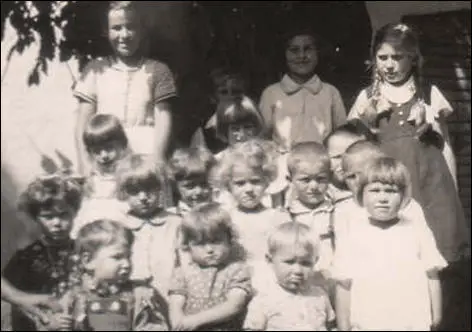
Ellen Voie was one of the children born in a Lebensborn maternity home: 'I stayed there until I was adopted aged two. My adoptive parents were incredibly cruel: they beat me and locked me in a small, dark room for hours. To this day I'm still afraid of the dark and have nightmares.... I was very disruptive; I couldn't concentrate. When I was 16 the local priest refused to confirm me because I did not have a baptism certificate. I had to go to the local authority where I found out that my parents had changed my name. (104)
Louis P. Lochner, an American journalist, claims that in the autumn of 1937, he was travelling on a local Bavarian train when a girl passenger suddenly announced: "I am going to the SS Ordensburg Sonthofen to have myself impregnated." (105) Incidents like this started rumours that the SS was running "stud farms". As a result mothers warned their daughters to keep clear of SS men for fear that they would be "spirited off to one of the homes and used for breeding". (106)
Clothes and Makeup
Adolf Hitler had strong views on women. He described his own ideal woman as "a cute, cuddly, naïve little thing - tender, sweet, and stupid." (107) This is why he was attracted to Eva Braun. According to Alan Bullock, the author of Hitler: A Study in Tyranny (1962): "Hitler became genuinely fond of Eva. Her empty-headedness did not disturb him; on the contrary, he detested women with views on their own." (108)
Hitler also disliked women who smoked and wore make-up. He made it clear about how young women in Nazi Germany should behave. The American journalist, Wallace R. Deuel, pointed out that he read in the Völkischer Beobachter, a newspaper controlled by the Nazi Party, that: "The most unnatural thing we can encounter in the streets is a German woman, who, disregarding all laws of beauty, has painted her face with Oriental warpaint." (109) Marianne Gärtner, a 12-year-old member of the German Girls' League (BDM), was told at one meeting: "A German woman does not use make-up! Only Negroes and savages paint themselves! A German woman does not smoke! She has a duty to her people to keep fit and healthy! (110)
The BDM played an important role in developing these values: "They were trained in Spartan severity, taught to do without cosmetics, to dress in the simplest manner, to display no individual vanity, to sleep on hard beds, and to forgo all culinary delicacies; the ideal image of those broad-hipped figures, unencumbered by corsets, was one of radiant blondeness, crowned by hair arranged in a bun or braided into a coronet of plaits. As a negative counter-image Nazi propaganda projected the combative, man-hating suffragettes of other countries." (111)
There was also a campaign against young women who smoked. Medical experts wrote articles claiming there was a positive correlation between excessive nicotine indulgence and infertility. One report argued that smoking harmed the ovaries and that a marriage between heavy smokers only produced 0.66 children on average compared to the normal average of three. (112)
If caught smoking, members of the BDM were in danger of being expelled. Hedwig Ertl, a loyal member of the BDM, fully supported these values: "The German woman must be faithful. She must not wear make-up and she should not smoke. She must be industrious and honest and she must want to have lots of children and be motherly." (113)
There was also a campaign in German newspapers against the idea of wearing trousers. Women were described as those "trouser-wenches with Indian warpaint". Magda Goebbels liked wearing trousers and she gained the support of her husband, Joseph Goebbels, to defend like-minded women: "Whether women wear slacks is no concern of the public. During the colder season women can safely wear trousers, even if the Party mutinies against this in one place or another. The bigotry bug should be wiped out." (114)
Strength Through Joy
Strength Through Joy (KdF) was established as a subsidiary of the German Labour Front. It was an attempt to organize workers' leisure time rather than allow them to organize it for themselves, and therefore enable leisure to serve the interests of the government. Robert Ley claimed that "workers were to gain strength for their work by experiencing joy in their leisure". (115) The scheme has been described as "regimented leisure" and that Hitler deemed it "necessary to control not only the working hours but the leisure hours of the individual". (116)
Albert Speer was a great supporter of Ley's plan to persuade factory owners to improve the workplace: "First we persuaded factory owners to modernize their offices and to have some flowers about. But we did not stop there. Lawn was to take the place of asphalt. What had been wasteland was to be turned into little parks where the workers could sit during breaks. We urged that window areas within factories be enlarged and workers' canteen set up... We provided educational movies and a counseling service to help businessmen on questions of illumination and ventilation... One and all devoted themselves to the cause of making some improvements in the workers' living conditions and moving closer to the ideal of a classless People's Community." (117)
Since the late 19th century the Social Democrat Party (SDP) and the German trade unions had built sports grounds and hiking hostels. These were now taken over by the German Labour Front and used for its members. With these resources it was able to offer discounted leisure activities that were within the financial reach of many workers and their families. By 1934-35, over three million people were taking part in its physical education and gymnastics evenings, while many others took advantage of the cheap coaching it offered in tennis, golf, skiing, sailing and other upper-middle-class-sports. (118)
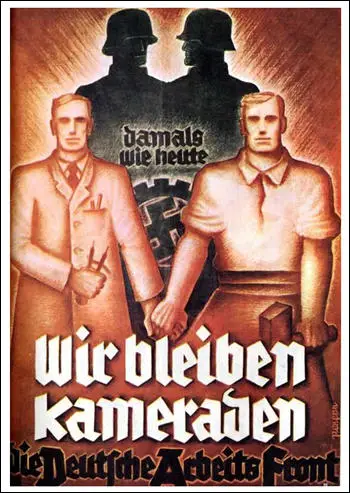
Strength Through Joy promoted evening classes, amateur cultural activities, recitals and travelling art exhibitions. Plays were performed in factories and specially organized KdF concerts, featuring important classical conductors and soloists, such as Carl Bohm, Eugen Jochum and Wilhelm Furtwanger, played to German workers. (119) The KdF had its own ninety-piece symphony orchestra which continually toured the country and in 1938 over two and a half million people attended its concerts. One observer pointed out that the KdF "made available at bargain rates tickets to the theatre, the opera and concerts, thus making available more highbrow entertainment to the labouring man." (120)
The success of the KdF brought Ley into conflict with Joseph Goebbels. According to his biographer, Toby Thacker, Goebbels objected to the idea that the professional associations of German artists should be part of the Labour Front. (121) Goebbels held a meeting with Adolf Hitler and eventually he agreed that he should be free to organize all persons "belonging to the areas of activity under his jurisdiction". (122)
In December 1935, Strength Through Joy arranged for 10,000 Germans to travel to London to watch their team play England at White Hart Lane. It was a curious choice of venue because within football Spurs are known as “the Jewish club” owing to support from Jewish communities in north London. There were also Jews among the players. On the day of the match a demonstration march converged on White Hart Lane. Leaflets printed in German were handed out by demonstrators and there were some minor scuffles with pro-Nazi sympathisers. Before the game the German players gave the nazi salute and the swastika was flown over the ground. England won the game 3-0. (123)
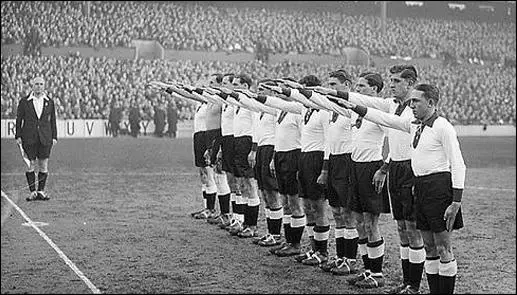
The most popular aspect of Strength Through Joy was the provision of subsidized holidays. Large sections of the labour force were for the first time given the opportunity of holidaying away from home. The holidays ranged in price from a week in the Harz Mountains (28 marks), one week at the North Sea coast (35 marks) and a fortnight at Lake Constance (65 marks). As the average wage of an industrial worker was about 30 marks, it enabled a third of all workers to go on holiday. (124)
The KdF set about building its own model resort on the Baltic island of Rügen. Construction began under the supervision of Albert Speer on 3rd May 1936. "The resort spanned eight kilometres of the Baltic shore, with six-story residence blocks interspersed with refectories and centred on a huge communal hall designed to accommodate all 20,000 of the resort's holidaymakers as they engaged in collective demonstration of enthusiasm for the regime and its policies. It was consciously designed for families, to make good the lack of facilities for them in other Strength Through Joy enterprises, and it was intended to be cheap enough for the ordinary worker to afford, at a price of no more than 20 Reichsmarks for a week's stay." (125)
The better paid workers were able to go abroad. A tour of Italy cost 155 marks. Strength Through Joy commissioned the building of two 25,000-ton purpose-built ships and chartered ten others to handle ocean cruises. The Robert Ley could carry 1,600 passengers. It only had forty lavatories and 100 showers but 156 loudspeakers that relayed on-board propaganda. (126) The liner also included a gymnasium, a theatre and a swimming pool to ensure that participants engaged in regular healthy exercise and experienced serious cultural events. (127)
These cruise liners sailed as far as the Norwegian fjords, Madeira, Libya, Finland, Bulgaria and Turkey. 180,000 Germans went on cruises in 1938 and the volume of tourism doubled. (128) In 1939 alone, 175,000 people went to Italy on organized trips, a good number of them travelling on cruise liners. (129)
William L. Shirer, an American journalist went on a KdF cruise: "Though life abroad was organized by Nazi leaders to a point of excruciation, the German workers seemed to have a good time. And at bargain rates! A cruise to Maderia, for instance, cost only $25, including rail fare to and from the German port, and other jaunts were equally inexpensive... In winter special skiing excursions to the Bavarian Alps were organized at a cost of $11 a week, including car fare, room and board, rental of skis and lessons from a ski instructor." (130)
The governments of other European countries took an interest in what the KdF was doing. The British ambassador in Berlin, Sir Neville Henderson, pointed out: "There are, in fact, many things in the Nazi organization and ideology, which we might study and adapt to our own use with great profit both to the health and happiness of our own nation and old democracy." (131)
Workers in Nazi Germany
The German Labour Front deprived the workers of any bargaining mechanism. The employer, with the support of the Labour Front, was able to decide on the amount that the workforce were paid. A wage freeze was decreed in 1933 and was enforced by the Labour Front during the period that the Nazis were in power, despite rising costs of living. "The Labour Front had become a gigantic state prison from which workers had no way out." (132)
There was little resistance to the policies of the Labour Front. In June 1936, there was a seventeen-minute stoppage at Rüsselsheim Opel Works by 262 workers protesting against a wage cut brought about by raw-material shortages. The leaders were immediately arrested and over 40 of the men were blacklisted. These tactics appeared to work. In 1928 a total of 20,339,000 days were lost to strikes. After the formation of the Labour Front, there were no recorded strikes in Nazi Germany. (133)
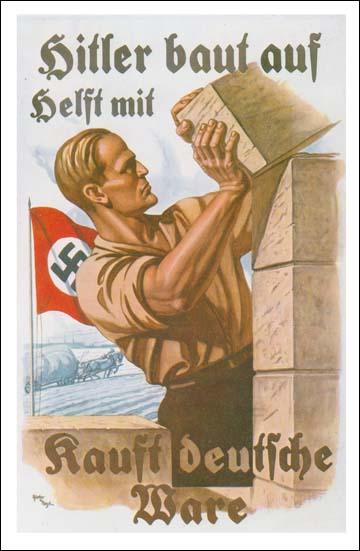
In 1935 Robert Ley claimed that Germany was the first country in Europe to overcome the class struggle. Although millions more had jobs, the share of all German workers in the national income fell from 56.9% in the depression year of 1932 to 53.6% in the boom year of 1938. At the same time income from capital and business rose from 17.4% of the national income for 26.6%. (134)
William L. Shirer, the author of The Rise and Fall of Nazi Germany (1959) states: "All the propagandists in the Third Reich from Hitler on down were accustomed to rant in their public speeches against the bourgeois and the capitalist and proclaim their solidarity with the worker. But... the official statistics... revealed that the much maligned capitalists, not the workers, benefited most from Nazi policies." (135)
Corruption in the Labour Front
Robert Ley told the workers at the Siemens factory in Berlin: "We are all soldiers of labour, amongst whom some command and the others obey. Obedience and responsibility have to count amongst us again... We can't all be on the captain's bridge, because then there would be nobody to raise the sails and pull the ropes. No, we can't all do that, we've got to grasp the fact." (136)
One historian has claimed that the Labour Front was "the most corrupt of all the major institutions of the Third Reich." (137) In the early months of 1935, German newspapers reported over one hundred cases of misappropriation of funds involving officials of the Winter Relief, one of the schemes operated by the Labour Front. This led to so many rumours and speculations that the Labour Front decided to discontinue door-to-door collection of subscriptions in favour of deductions from wages. (138)
The Labour Front eventually had 25.3 million members. Each worker had 1.5 per cent of their wages deducted to cover costs. By 1937 the annual income from membership fees to the Labour Front reached $160,000,000. How this money was spent remained a secret as Ley never published the accounts of the organization. It was believed that the institution was open to corruption. It was also claimed that Ley stole money that had been confiscated from former trade unions. (139)
Ley was well rewarded for his role in the movement. As head of the Labour Front he was granted a salary of 4,000 Reichsmarks. His income was increased by 2,000 Reichsmarks as Reich Organization Leader of the Party, 700 Reichsmarks as a Reichstag deputy, and 400 Reichsmarks as a Prussian State Councillor. He also received royalties from books and pamphlets, which Labour Front officials were encouraged to buy in bulk for distribution to the members.
According to Richard Evans, the author of The Third Reich in Power (2005), "Ley... bought a whole series of grand villas in the most fashionable districts of Germany's towns and cities. The running costs, which in his villa in Berlin's Grunewald included a cook, two nannies, a chambermaid, a gardener and a housekeeper, were met by the Labour Front up to 1938, and even after that it paid all Ley's entertainment expenses. He was fond of expensive automobiles and gave two to his second wife as presents. Ley also had a railway carriage refitted for his personal use. He collected paintings and furniture for his houses." (140)
References
(1) Louis L. Snyder, Encyclopedia of the Third Reich (1998) page 84
(2) Ian Kershaw, Hitler 1889-1936 (1998) pages 466-468
(3) John Simkin, Hitler (1988) page 40
(4) William L. Shirer, The Rise and Fall of Nazi Germany (1959) page 252
(5) Louis L. Snyder, Encyclopedia of the Third Reich (1998) page 64
(6) Robert Ley, proclamation (May, 1933)
(7) William L. Shirer, The Rise and Fall of Nazi Germany (1959) pages 253-254
(8) Richard Evans, The Third Reich in Power (2005) pages 460
(9) Martin Kitchen, The Third Reich (2004) page 138
(10) Michael Burleigh, The Third Reich: A New History (2001) page 675
(11) Richard Grunberger, A Social History of the Third Reich (1971) page 362
(12) Ian Kershaw Hitler 1889-1936 (1998) page 17
(13) Adolf Hitler, Mein Kampf (1925) page 22
(14) Cate Haste, Nazi Women (2001) page 101
(15) Louis L. Snyder, Encyclopedia of the Third Reich (1998) page 79
(16) Wilhelm Frick, directive issued on 9th May, 1933
(17) Richard Evans, The Third Reich in Power (2005) page 263
(18) Louis L. Snyder, Encyclopedia of the Third Reich (1998) page 303
(19) Tomi Ungerer, Tomi: A Childhood under the Nazis (1998) page 63
(20) Richard Evans, The Third Reich in Power (2005) page 264
(21) Tomi Ungerer, Tomi: A Childhood under the Nazis (1998) page 63
(22) Marianne Gärtner, The Naked Years: Growing up in Nazi Germany (1987) page 36
(23) Tomi Ungerer, Tomi: A Childhood under the Nazis (1998) page 46
(24) Bernhard Rust, National Socialist Germany and the Pursuit of Learning (1936)
(25) Inge Scholl, The White Rose: 1942-1943 (1983) page 7
(26) Bernhard Rust, National Socialist Germany and the Pursuit of Learning (1936)
(27) Elsbeth Emmerich, Flying a Flag for Hitler (1991) pages 27-28
(28) Hans Massaquoi, interviewed by Studs Terkel for his book, The Good War (1985) page 497
(29) Anonymous, Six Years Education in Nazi Germany (1945)
(30) Effie Engel, interviewed by the authors of What We Knew: Terror, Mass Murder and Everyday Life in Nazi Germany (2005) page 211
(31) Richard Grunberger, A Social History of the Third Reich (1971) page 364
(32) Louis L. Snyder, Encyclopedia of the Third Reich (1998) page 79
(33) Dr. Schuster, geography teacher, writing in 1938.
(34) Anonymous schoolteacher, letter to a friend (December, 1938)
(35) Herbert Lutz, interviewed by the authors of What We Knew: Terror, Mass Murder and Everyday Life in Nazi Germany (2005) page 145
(36) Richard Evans, The Third Reich in Power (2005) page 268
(37) Tomi Ungerer, Tomi: A Childhood under the Nazis (1998) page 78
(38) Irmgard Paul, On Hitler's Mountain: My Nazi Childhood (2005) pages 177
(39) Hildegard Koch, Nine Lives Under the Nazis (2011) page 198
(40) Erich Dressler, Nine Lives Under the Nazis (2011) page 65
(41) Michael Burleigh, The Third Reich: A New History (2001) page 236
(42) Ilse Koehn, Mischling, Second Degree: My Childhood in Nazi Germany (1977) page 33
(43) Irmgard Paul, On Hitler's Mountain: My Nazi Childhood (2005) page 121
(44) Richard Evans, The Third Reich in Power (2005) page 270
(45) Richard Evans, The Third Reich in Power (2005) page 265
(46) Louis L. Snyder, Encyclopedia of the Third Reich (1998) page 79
(47) Richard Evans, The Third Reich in Power (2005) page 265
(48) Louis L. Snyder, Encyclopedia of the Third Reich (1998) page 79
(49) Tomi Ungerer, Tomi: A Childhood under the Nazis (1998) page 79
(50) Irmgard Paul, On Hitler's Mountain: My Nazi Childhood (2005) page 183
(51) Richard Grunberger, A Social History of the Third Reich (1971) page 376
(52) James Taylor and Warren Shaw, Dictionary of the Third Reich (1987) page 82
(53) Richard Grunberger, A Social History of the Third Reich (1971) page 376
(54) James Taylor and Warren Shaw, Dictionary of the Third Reich (1987) page 82
(55) Richard Grunberger, A Social History of the Third Reich (1971) page 408
(56) Wilhelm Frick, order issued on 12th January, 1934.
(57) Richard Grunberger, A Social History of the Third Reich (1971) pages 363
(58) Joseph Goebbels, speech in Munich (1934)
(59) Richard Evans, The Third Reich in Power (2005) page 297
(60) Frankfurter Zeitung (16th January, 1937)
(61) Richard Grunberger, A Social History of the Third Reich (1971) pages 373
(62) Richard Grunberger, A Social History of the Third Reich (1971) pages 320-21
(63) Michael Burleigh, The Third Reich: A New History (2001) pages 122-123
(64) Richard Grunberger, A Social History of the Third Reich (1971) pages 324
(65) William L. Shirer, The Rise and Fall of Nazi Germany (1959) page 171
(66) Cate Haste, Nazi Women (2001) page 74
(67) Melita Maschmann, Account Rendered: A Dossier on My Former Self (1964) page 15
(68) Joseph Goebbels, speech in Munich (March, 1933)
(69) Adolf Hitler, speech to the NSDAP Women's Organization (September, 1934)
(70) Cate Haste, Nazi Women (2001) page 88
(71) Adolf Hitler, speech (September, 1935)
(72) Marianne Gärtner, The Naked Years: Growing up in Nazi Germany (1987) page 55
(73) Cate Haste, Nazi Women (2001) page 85
(74) Richard Evans, The Third Reich in Power (2005) page 331
(75) Nazi Racial Policy Bureau, ten rules to be observed when considering a marriage partner (1934)
(76) Richard Evans, The Third Reich in Power (2005) page 331
(77) Gertrud Scholtz-Klink, speech (July, 1934)
(78) Daniel Fuchs, The Limits of Ferocity: Sexual Aggression and Modern Literary Rebellion (2011) page 123
(79) Gertrud Scholtz-Klink, To Be German Is to Be Strong (1936)
(80) Cate Haste, Nazi Women (2001) page 96
(81) Wilhelm Frick, order issued on 12th January, 1934.
(82) Richard Grunberger, A Social History of the Third Reich (1971) pages 363
(83) Joseph Goebbels, speech in Munich (1934)
(84) Richard Evans, The Third Reich in Power (2005) page 297
(85) Cate Haste, Nazi Women (2001) page 91
(86) Lisa Pine, Nazi Family Policy (1997) page 46
(87) Peter Padfield, Himmler: Reichsfuhrer S.S. (1991) page 167
(88) Hildegard Koch, Nine Lives Under the Nazis (2011) page 204
(89) Andrew Mollo, To The Death's Head: The Story of the SS (1982) page 75
(90) Peter Padfield, Himmler: Reichsfuhrer S.S. (1991) page 167
(91) Heinrich Himmler, memorandum to Schutzstaffel (SS) officers (13th September 1936)
(92) Cate Haste, Nazi Women (2001) page 117
(93) Hugh Trevor Roper, Hitler's Table Talk 1941-1944 (1953) page 352
(94) Lisa Pine, Nazi Family Policy (1997) page 39
(95) Cate Haste, Nazi Women (2001) page 116
(96) Richard Grunberger, A Social History of the Third Reich (1971) page 314
(97) Heinrich Himmler, in conversation with Felix Kersten (1943)
(98) Hildegard Koch, Nine Lives Under the Nazis (2011) page 196
(99) Hildegard Koch, Nine Lives Under the Nazis (2011) page 202
(100) Jean Schlösser, interviewed by Richard Grunberger (May, 1966)
(101) Hildegard Koch, Nine Lives Under the Nazis (2011) page 202
(102) David Crossland, Der Spiegel (7th November, 2006)
(103) Cate Haste, Nazi Women (2001) page 117
(104) Rob Sharp, The Independent (20th January 2008)
(105) Louis P. Lochner, What About Germany? (1942) page 308
(106) Cate Haste, Nazi Women (2001) page 117
(107) Ian Kershaw, Hitler 1889-1936 (1998) page 45
(108) Alan Bullock, Hitler: A Study in Tyranny (1962) page 396
(109) Wallace R. Deuel, People Under Hitler (1942) page 161
(110) Marianne Gärtner, The Naked Years: Growing up in Nazi Germany (1987) page 54
(111) Richard Grunberger, A Social History of the Third Reich (1971) page 335
(112) G. Wenzmer, Should Women be Allowed to Smoke? Hamburger Fremdenblatt (22nd March 1944)
(113) Hedwig Ertl, interviewed by Cate Haste, for her book, Nazi Women (2001) page 95
(114) Joseph Goebbels, speech (7th October, 1940)
(115) Richard Evans, The Third Reich in Power (2005) pages 466
(116) William L. Shirer, The Rise and Fall of Nazi Germany (1959) page 330
(117) Albert Speer, Inside the Third Reich (1970) page 99
(118) Richard Evans, The Third Reich in Power (2005) pages 466
(119) Michael Burleigh, The Third Reich: A New History (2001) page 250
(120) Richard Grunberger, A Social History of the Third Reich (1971) page 255
(121) Toby Thacker, Joseph Goebbels: Life and Death (2009) page 156
(122) Ralf Georg Reuth, Joseph Goebbels (1993) page 186
(123) Paul Sorene, When Nazi Germany Saluted England At Spurs’ White Hart Lane (28th November, 2014)
(124) James Taylor and Warren Shaw, Dictionary of the Third Reich (1987) page 167
(125) Richard Evans, The Third Reich in Power (2005) pages 469
(126) Michael Burleigh, The Third Reich: A New History (2001) page 250
(127) Richard Evans, The Third Reich in Power (2005) pages 468
(128) James Taylor and Warren Shaw, Dictionary of the Third Reich (1987) page 280
(129) Richard Evans, The Third Reich in Power (2005) pages 467
(130) William L. Shirer, The Rise and Fall of Nazi Germany (1959) pages 330-331
(131) Sir Neville Henderson, Failure of a Mission (1940) page 15
(132) Louis L. Snyder, Encyclopedia of the Third Reich (1998) page 209
(133) Richard Grunberger, A Social History of the Third Reich (1971) page 257
(134) Robert Ley, speech in Berlin (1st November, 1933)
(135) William L. Shirer, The Rise and Fall of Nazi Germany (1959) pages 329
(136) Richard Evans, The Third Reich in Power (2005) pages 462
(137) Richard Grunberger, A Social History of the Third Reich (1971) pages 132-133
(138) William L. Shirer, The Rise and Fall of Nazi Germany (1959) page 331
(139) Martin Kitchen, The Third Reich (2004) page 138
(140) Richard Evans, The Third Reich in Power (2005) pages 463
John Simkin
